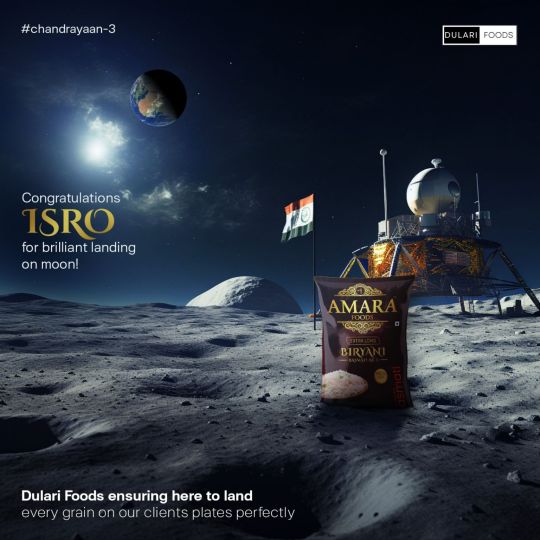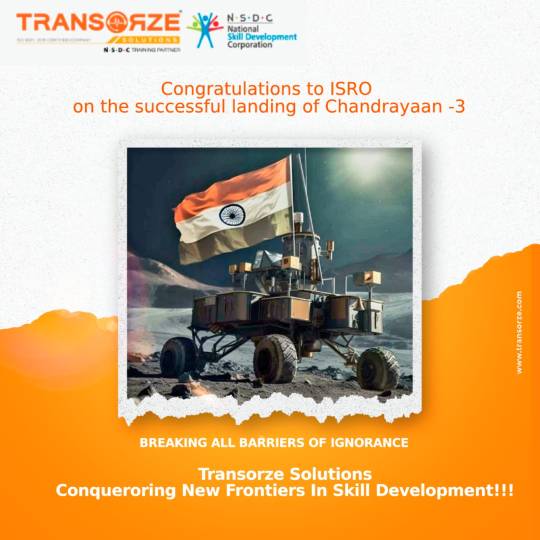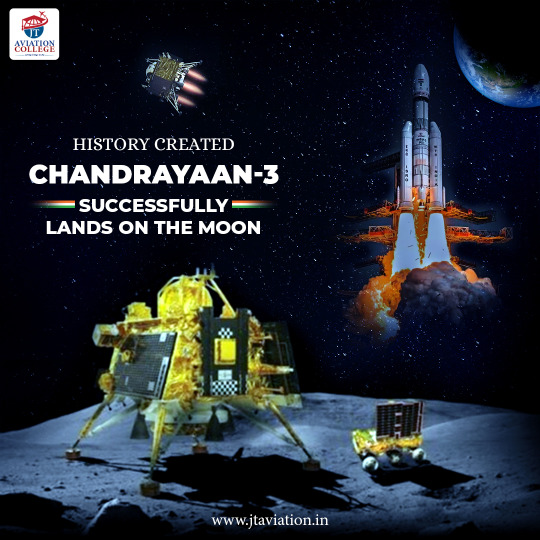#Chandrayaan_3
Text
Chandraayan 3!!
India soars in pride as we celebrate the victory of Chandraayan 3!!
Spread the fragrance of rich Indian heritage with Prabhu Shriram- Incense with a Story
#Chandryaan#Chandrayaan_3#celebration#isro#mahadev#chandrayaan#india#space#incensewithstory#prabhushrir#mangalyaan#gaganyaan#nasa#satellite#isromissionsam
2 notes
·
View notes
Link
The idea of using resources in situ opens up the possibility of building a base on the moon and using sulfur as a resource to create solar panels, fertilizers, and concrete On August 23, 2023, the Indian lander Chandrayaan-3 landed at a distance of 600 km from the South Pole of the Moon. For about 14 Earth days, Chandrayaan-3 provided scientists with new data to study the Moon. The Indian Space Research Organization shared the first results. [caption id="attachment_65723" align="aligncenter" width="780"] Chandrayaan-3[/caption] While data from the unmanned Chandrayaan-3 rover, named Pragyan, meaning "wisdom" in Sanskrit, showed that the lunar regolith contains expected elements such as iron, titanium, aluminum, and calcium, it also showed unexpectedly high concentrations of sulfur. Planetary scientists have always known that sulfur exists in lunar rocks, but they were confident that the concentration was very low. New measurements indicate higher sulfur concentrations than expected. Pragyan has two instruments that analyze the elemental composition of soil - an X-ray spectrometer and a laser-induced degradation spectrometer, or LIBS. Both of these instruments measured sulfur near the planting site. There are two main types of rocks on the surface of the Moon - dark volcanic rocks and light rocks. The difference in brightness between these materials creates the familiar "face on the moon" image. Scientists measuring the composition of lunar rocks and soil in laboratories on Earth have found that material from dark volcanic plains typically contains more sulfur than material from light-colored mountainous regions. Sulfur is mainly a result of volcanic activity. Sulfur is found in deep layers, and when these rocks melt, the sulfur becomes part of the magma. When molten rock reaches the surface, most of the sulfur in the magma turns into gas, which is released along with water vapor and carbon dioxide. Some sulfur remains in the magma and is retained within the rock after it cools. This process explains why sulfur is mainly found in the dark volcanic rocks of the Moon. [caption id="attachment_65724" align="aligncenter" width="600"] Chandrayaan-3[/caption] The sulfur measurements from Chandrayaan-3 were the first on the lunar surface. The exact amount of this element will be known when a full analysis of the data is completed. So far, data collected by the LIBS instrument on Pragyan suggests that the moon's mountainous regions near the poles may have higher sulfur concentrations than equatorial regions and perhaps even higher than dark volcanic soils. Measuring the amount and distribution of sulfur is interesting to scientists for at least two reasons. First, these discoveries indicate that the polar regions of the Moon may have fundamentally different composition compared to mountainous regions in the equatorial regions of the Moon. This difference in composition is likely due to different environmental conditions between the two regions—the polar regions receive less direct sunlight. [caption id="attachment_65725" align="alignnone" width="600"] Chandrayaan-3[/caption] Second, these results indicate that there is some sulfur in the polar regions. The sulfurous materials could have formed from the extremely thin lunar atmosphere. The polar regions of the Moon receive less direct sunlight and, as a result, experience extremely cold temperatures compared to the rest of the Moon. If the surface temperature drops below -73 degrees Celsius, sulfur from the lunar atmosphere can condense and settle on the surface in solid form. Sulfur in the polar regions could also come from ancient volcanic eruptions on the surface of the Moon or from meteorites containing sulfur. Many space agencies are thinking about establishing a base on the Moon for long-term space missions. Astronauts and robots will be able to travel from a base at the South Pole to collect, process, store, and use materials such as sulfur on the Moon. Utilizing resources locally means fewer trips to Earth for supplies and longer time spent on research. Using sulfur as a resource, astronauts will be able to create solar panels and batteries and use them in fertilizers and concrete. Sulfur in concrete has advantages over conventional concrete used in the construction of objects on Earth. First, sulfur concrete hardens and becomes strong in hours rather than weeks, and it is more resistant to abrasion. Plus, it doesn't require water to make, so astronauts can save water for drinking and producing oxygen and rocket fuel. There are currently seven missions operating on the Moon, but the Moon's south pole has not previously been studied from the surface, new measurements from the Pragyan rover will help planetary scientists understand the geological history of the Moon. It will also allow scientists to learn more about how the Moon formed and evolved.
#Chandrayaan_series#Chandrayaan_3#Indian_space_mission#ISRO_spacecraft#lunar_exploration#lunar_lander#lunar_mission#lunar_rover#space_exploration#space_technology
0 notes
Text

Read Current Science Report for the month of September
#AI#ChatGPT#JWST#CHANDRAYAAN_3#AdityaL1#CERN#artificial intelligence#current science#nasa#covid19#education#elonmusk#science#science news
0 notes
Text

Congratulations #Isro for brilliant landing on moon!
#DulariFoods ensuring here to land every grain on our clients plates perfectly.
#chandrayan3#moon#space#rover#chandrayaan3#softlanding#india#lunar#chandrayaan3mission#Chandrayaan_3#VikramLander#isrochandrayaan3mission#ISRO#चंद्रयान_3#Chandrayaan3
0 notes
Text

Hats off to 𝐈𝐒𝐑𝐎 for a flawless touchdown with 𝐂𝐡𝐚𝐧𝐝𝐫𝐚𝐲𝐚𝐚𝐧 𝟑! 🌟
𝗜𝗻𝗱𝗶𝗮 𝗕𝗲𝗰𝗼𝗺𝗲 𝟭𝘀𝘁 𝗰𝗼𝘂𝗻𝘁𝗿𝘆 𝗶𝗻 𝗪𝗼𝗿𝗹𝗱 𝘁𝗼 𝗟𝗮𝗻𝗱 𝗢𝗻 𝗟𝘂𝗻𝗮𝗿 𝗦𝗼𝘂𝘁𝗵 𝗣𝗼𝗹𝗲
Breaking through Earth's bonds, Chandrayaan 3 gracefully touches the lunar soil, a celestial dance orchestrated by ISRO. A standing ovation to India's scientific prowess and the relentless spirit of exploration! 🌠🌕
Their journey to the moon's surface is an inspiration that reaches for the stars and beyond. 🚀🌕
For more details:
🌐 www.transorze.com
☎️ 9495833319
#chandrayaan3launch#chandrayaan3mission#Chandrayaan3#isroindia#isromissions#scientist#achieve#achievement#Chandrayaan_3#successful#ISRO#landing#moon#lunar#lunarcycle#proudest#first#highlights#moonmission2023#transorze#transorzesolutions#kochi
0 notes
Text

Hats off to 𝐈𝐒𝐑𝐎 for a flawless touchdown with 𝐂𝐡𝐚𝐧𝐝𝐫𝐚𝐲𝐚𝐚𝐧 𝟑! 🌟
𝗜𝗻𝗱𝗶𝗮 𝗕𝗲𝗰𝗼𝗺𝗲 𝟭𝘀𝘁 𝗰𝗼𝘂𝗻𝘁𝗿𝘆 𝗶𝗻 𝗪𝗼𝗿𝗹𝗱 𝘁𝗼 𝗟𝗮𝗻𝗱 𝗢𝗻 𝗟𝘂𝗻𝗮𝗿 𝗦𝗼𝘂𝘁𝗵 𝗣𝗼𝗹𝗲
Breaking through Earth's bonds, Chandrayaan 3 gracefully touches the lunar soil, a celestial dance orchestrated by ISRO. A standing ovation to India's scientific prowess and the relentless spirit of exploration! 🌠🌕
Their journey to the moon's surface is an inspiration that reaches for the stars and beyond. 🚀🌕
For more details:
🌐 www.transorze.com
☎️ 9495833319
#chandrayaan3launch#chandrayaan3mission#Chandrayaan3#isroindia#isromissions#scientist#achieve#achievement#Chandrayaan_3#successful#ISRO#landing#moon#lunar#lunarcycle#proudest#first#highlights#moonmission2023#transorze#transorzesolutions#kochi
0 notes
Text
#sarkariyojana#govtschemes#sarkariyojna#CentralSchemes#Chandrayaan_3#chandrayaan3isro#chandrayaan3launch
0 notes
Text

1 note
·
View note
Text

Congratulations To Our ISRO Team
From ASHRA TECHNOLOGIES
Chandrayan 3 Successfully Landed At 6.04 PM
.
.
.
.
.
.
.
.
0 notes
Text

Congratulations To Our ISRO Team
From S Car Rentals
Chandrayan 3 Successfully Landed At 6.04 PM
.
.
.
.
.
.
.
.
0 notes
Link
ISRO's Chandrayaan-3 Rover Completes Lunar Mission India's space agency, ISRO, has successfully concluded its lunar mission, marking a significant milestone in lunar exploration. Exploring India's Lunar Success and Future Endeavors The Indian Space Research Organisation (ISRO) has achieved another remarkable feat in space exploration with the successful completion of its lunar mission, Chandrayaan-3. The mission, which included the Pragyan rover, has garnered international attention for its scientific discoveries on the moon's surface. In this article, we delve into the details of ISRO's lunar success and its upcoming solar mission. Pragyan Rover's Achievements Lunar South Pole Exploration: The Pragyan rover, a vital component of the Chandrayaan-3 spacecraft, embarked on a groundbreaking journey to the lunar south pole, making India one of the select few countries to achieve this feat. ISRO's Chandrayaan-3 Scientific Discoveries: During its mission, Pragyan covered a distance of over 100 meters (330 feet) on the lunar surface. The rover's experiments confirmed the presence of essential elements such as sulfur, iron, oxygen, and more, contributing valuable data to lunar research. Transition to 'Sleep Mode' Mission Completion: Following its two-week assignment on the lunar surface, the Pragyan rover was placed in "Sleep mode." While in this state, the rover's batteries remain charged, and its receiver remains active, awaiting potential future assignments. Hope for Awakening: ISRO expressed optimism for the rover's reactivation for future missions. However, if not awakened, Pragyan will forever stand as India's lunar ambassador, marking a historic achievement. Lunar Milestones India's Lunar Presence: India's Chandrayaan-3 mission solidified its position among leading space nations, including the United States, China, and the former Soviet Union, which have also reached the moon. South Pole Triumph: Chandrayaan-3's successful touchdown at the rugged lunar south pole added to its significance, especially considering Russia's Luna-25's recent crash during a similar attempt. Future Solar Mission Studying the Sun: India's space endeavors continue with the launch of a solar mission aimed at studying the sun and observing solar winds. These solar winds can lead to disturbances on Earth, often seen as beautiful auroras. Satellite Status: ISRO confirmed that the satellite for the solar mission is in good health and positioned in Earth's orbit, preparing for its extensive 1.5 million-kilometer (930,000-mile) journey. Frequently Asked Questions about ISRO's Chandrayaan-3 What were the key discoveries made by the Pragyan rover on the moon? The Pragyan rover confirmed the presence of elements such as sulphur, iron, oxygen, and more on the lunar surface. Why is the Pragyan rover in "Sleep mode"? The rover has been placed in "Sleep mode" after completing its mission, with the hope of future reactivation for additional assignments. What is the significance of Chandrayaan-3's lunar touchdown? Chandrayaan-3's successful landing at the lunar south pole solidified India's position among leading lunar explorers. What is the focus of ISRO's upcoming solar mission? The solar mission aims to study the sun and observe solar winds that can cause disturbances on Earth, such as auroras.
#auroras#Chandrayaan_3#ISRO#lunar_ambassador#lunar_milestones#lunar_mission#lunar_surface#lunar_touchdown#Pragyan_rover#scientific_discoveries#Sleep_mode#Solar_Mission#solar_winds#south_pole#space_exploration#space_nations
0 notes
Text

Historical achievement for India. 🇮🇳
𝐂𝐡𝐚𝐧𝐝𝐫𝐚𝐲𝐚𝐚𝐧-𝟑 has successfully soft-landed in the Moon's South Polar Region proudly making India the first country to achieve this success. 🌕
.
.
.
#Chandrayaan_3#india#ISRO#space#chandrayan3#chandrayaan3launch#VikramLander#chandrayaan3mission#success#feelingproud#bestwishes#Chandrayaan3Landing
1 note
·
View note
Text

India has created History Again!! 🇮🇳
𝗖𝗵𝗮𝗻𝗱𝗿𝗮𝘆𝗮𝗮𝗻-𝟯 has successfully touched the surface of the Moon proudly making India the first country to soft land in the South Polar Region of the Moon. 🌕
#Chandrayaan_3#india#ISRO#space#chandrayan3#chandrayaan3launch#chandrayaan3mission#success#feelingproud#bestwishes#Chandrayaan3Landing
0 notes
Text

Best wishes to #ISRO and #Chandrayaan-3, and to all, on the journey to explore the mysteries of space!
#Chandrayaan3#ISRO#ch3#moonlanding#Chandrayaan_3#Chandrayaan3Mission#PSLV#SAC#Landing#Moon#SouthPole#SpaceExploration#ScientificDiscovery#IndiaInSpace#ProudToBeIndian#ChandrayaanLanding
0 notes
Video
youtube
How the moon affects the tides? @factober #moon #spaceexploration
How the moon affects the tides? @factober #moon #spaceexploration https://youtu.be/4qVGUdnCM24 via @YouTube #moon #tides #geography #geology #science #science #earth #mamaearth #earthfacts #nature #naturefacts #moonfacts #moonlanding #Chandrayaan_3 #Chandrayaan3 #Chandrayan3
#youtube#moon#tides#geography#geology#science#earth#mamaearth#earthfacts#nature#naturefacts#moonfacts#moonlanding#Chandrayaan_3#Chandrayaan3#Chandrayan3
0 notes
Text

चांद पर भारत के अंतरिक्ष यान चंद्रयान-3 की सफल लैंडिंग के लिए समस्त देशवासियों और इसरो के वैज्ञानिकों को हार्दिक बधाई । यह समस्त देशवासियों के लिए अपार प्रसन्नता का अवसर है । हमारे वैज्ञानिकों की यह सफलता विश्व में अद्वितीय है । भारत विश्व में चांद के दक्षिणी ध्रुव पर अपने अंतरिक्ष यान की सफल लैंडिंग वाला प्रथम देश बन गया है । जय हिन्द !!
Chandrayaan-3 Mission: 'India🇮🇳, I reached my destination and you too!' - Chandrayaan-3
Chandrayaan-3 has successfully soft-landed on the moon 🌖!.
Congratulations, India🇮🇳! Jai Hind !!
#ISRO #IndianSpaceResearchOrganisation #चंद्रयान_3 #Ch3 #Chandrayaan3 #Chandrayaan_3 #chandrayaan #india #space #Moon #MissionAccomplished #Chandrayaan3Mission #isroindia #chandrayaan3launch #ISROMissions #IndiaMoonMission #23August #IndiaSpaceMission #MoonMission #VikramLander
#NarendraModi #PMOIndia
#YogiAdityanath #ChiefMinisterUttarPradesh
#HelpUTrust #HelpUEducationalandCharitableTrust
#KiranAgarwal #DrRupalAgarwal #HarshVardhanAgarwal
www.helputrust.org
@ISRO
@narendramodi @pmoindia
@MYogiAdityanath @cmouttarpradesh
@HelpUEducationalAndCharitableTrust @HelpU.Trust
@KIRANHELPU
@HarshVardhanAgarwal.HVA @HVA.CLRS @HarshVardhanAgarwal.HelpUTrust
@HelpUTrustDrRupalAgarwal @RupalAgarwal.HELPU @drrupalagarwal
@HelpUTrustDrRupal
10 notes
·
View notes